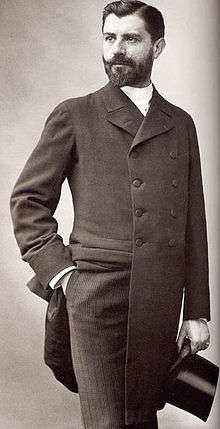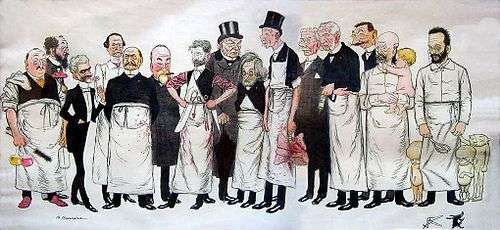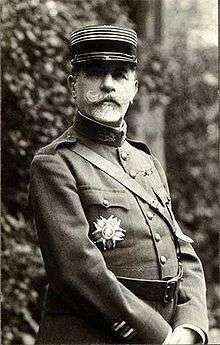Samuel Jean de Pozzi

Samuel-Jean Pozzi (3 October 1846 – 13 June 1918) was a French surgeon and gynecologist. He was also interested in anthropology and neurology.
Early life
Samuel-Jean Pozzy (he changed the spelling later) was born in Bergerac, Dordogne to a family of Italian/Swiss descent. Samuel's father Benjamin Dominique Pozzy (March 20, 1820 – 1905), a minister of the Reformed Church of France, married Marthe-Marie Inés Escot-Meslon (March 11, 1821 – 1857) on April 29, 1844 in Bergerac, Dordogne, France. She died when Samuel was ten, and his father then married an Englishwoman, Mary Anne Kempe, on October 19, 1859 in Bakewell, Derbyshire, England.
Pozzi went to study first to Pau and then to Bordeaux. For his handsome appearance and cultured demeanor, other pupils nicknamed him The Siren.
Medical career

In 1864, Pozzi began to his study medicine in Paris. When the Franco-Prussian War broke out in 1870, he volunteered and became a medic. Later he was one of the pupils of the neurologist Paul Broca and as his assistant he worked with anthropology, neurology and comparative anatomy. Pozzi graduated as a doctor in 1873. His thesis was of treatment of obstetric fistula.
In 1875, Pozzi became a university teacher after his second thesis about using hysterotomy for uterine fibroma. In 1876, Pozzi traveled to Scotland to the Congress of the British Medical Association to meet Joseph Lister, whose interest in antiseptics he supported. In 1877, Pozzi became chirurgien des hôpitaux.
Pozzi went to Austria, Germany and Britain to study gynecological methods and became one of the pioneers of gynecology in France. He gained a reputation as a teacher, preferring to make his rounds dressed in white overalls and wearing a black cap.
In 1881, Pozzi became a hospital surgeon, specializing in gynecological and abdominal surgery. In 1883, he was appointed surgeon at the Hôpital de Lourcine-Pascal. After 1884 he gave theoretical lectures in the hospital. In 1888, he became a president of the Society of Anthropology – he had been a member since 1870. He traveled widely to supplement his knowledge.
Pozzi established the first Chair of Gynecology in Paris in 1884. In 1889, he performed the first gastroenterostomy in France. In 1896, he was elected to the French Academy of Medicine. In 1897, he was a co-founder of the Revue de gynécologie et de chirurgie abdominale.
In 1913, Pozzi and Georges Clemenceau organized the first transplant symposium in Paris. In 1914, he joined the forces again when the First World War broke out and became a military surgeon.
Personal life
In 1879, Pozzi married Therese Loth-Cazalis, heiress of a railroad magnate, and had three children: Catherine, Jean, and Jacques. His wife wanted her mother to live with them, which made for tensions in the marriage. Pozzi also had affairs: with the opera singer Georgette Leblanc, the actress Rejane, the widow of Georges Bizet, Sarah Bernhardt, and Emma Sedelmeyer Fischof. The daughter of an art dealer and wife of a horse breeder, Fischof was a beautiful, cultured woman of Jewish heritage who became Pozzi's mistress in 1890. His wife refused to grant him a divorce, but Firschhof remained his companion for the rest of his life.[1]
Relationship with Sarah Bernhardt
In his early days in Paris, Pozzi had met Sarah Bernhardt through a childhood friend, the actor Jean Mounet-Sully. According to Gustave Schlumberger, they briefly became lovers, then remained lifelong friends afterwards. In 1898, he commissioned painter Georges Clairin—probably through their common friend Bernhardt—to paint a painting for the wall of his Hospital, Lourcine. In 1898, Bernhardt insisted on Pozzi to operate on her ovarian cyst. In 1915, she called on him again, and Pozzi arranged for a colleague to amputate her damaged leg.
Political and cultural interests
Pozzi became an honorary member of the Cercle de l'Union artistique (known as the Mirlitons) in 1881, and met the painter John Singer Sargent.[2] Sargent's 1881 portrait of Pozzi depicts him in a red dressing gown and is currently display at the Armand Hammer Museum in Los Angeles.
Pozzi befriended Marcel Proust, Robert Proust and Robert de Montesquiou. In 1877 he came to know poet Louise Ackermann, when he asked her to teach him German. Salonniere Lydie Aubernon nicknamed him "the love doctor". He corresponded with a feminist writer Augustine Bulteau. He also collected coins and statuettes.
In 1898 Pozzi was elected senator from Bergerac and represented his district for three years. He improved the water supply and sewer drainage of his town and was later involved with the restructuring of the French baccalaureate exams. He did not seek re-election in 1902.
Pozzi witnessed the second trial of Alfred Dreyfus, and supported Émile Zola who believed that Dreyfus was innocent. In 1908 the ashes of Zola were transferred to the Pantheon and both Pozzi and Dreyfus were present. When the journalist Gregori shot at Dreyfus and wounded him on the arm, Pozzi rushed to his aid.
Death

On June 13, 1918, Maurice Machu, former patient from two years before, approached Pozzi in his consulting room. Pozzi had had to amputate his leg and he had become impotent. Machu asked him to operate again. When Pozzi refused because he could not remedy the situation, Machu shot him four times in the stomach. Pozzi ordered himself to be taken to the Historia Hospital but the emergency laparotomy was unsuccessful. He asked to be buried in his military uniform and died shortly afterwards. Machu committed suicide later.
Pozzi was buried in the Protestant cemetery in Bergerac. He was survived by his diplomat son Jean de Pozzi and poet daughter Catherine de Pozzi.
Publications
- Étude sur les fistules de l’espace pelvi-rectal supérieur etc. Doctoral thesis, Paris, 1871
- De la valeur de l’hystérotomie dans le traitement des tumeurs fibreuses de l’utérus. Thèse d’agrégation, Paris, 1875
- Traité de gynécologie clinique et opératoire (Paris, 1890; 2nd edition, 1891; 4th edition, 1905–1907. Translated into six languages.
Pozzi wrote over 400 papers on surgery. His gynaecology text of 1890 was translated into five languages, and with revisions remained an authority to the 1930s.[3]
In 1874, Pozzi and Réné Benoit published a translation of Charles Darwin's The Expression of the Emotions in Man and Animals. He wrote the first French texts about antiseptic methods, after his visit to Lister.
References
- ↑ Caroline De Costa (28 October 2010). The Diva and Doctor God. Xlibris Corporation. ISBN 978-1-4535-7965-7. Retrieved 29 April 2012.
- ↑ Ormond & Elaine Kilmurray, Richard (2015). Sargent: Portraits of Artists and Friends. New York: Skira Rizzoli. ISBN 978-0847845279.
- ↑ Leonard L. LaPointe (1 September 2012). Paul Broca and the Origins of Language in the Brain. Plural Publishing. p. 154. ISBN 978-1-59756-604-9.
- Caroline de Costa and Francesca Miller – Portrait of A Ladies'Man: Dr Samuel-Jean Pozzi (History Today March 2006)
External links
- Samuel Jean de Pozzi in whonamedit.com
- Dr Samuel-Jean Pozzi (1846–1918)
- Dr. Pozzi in cyberbiologie (in French)
